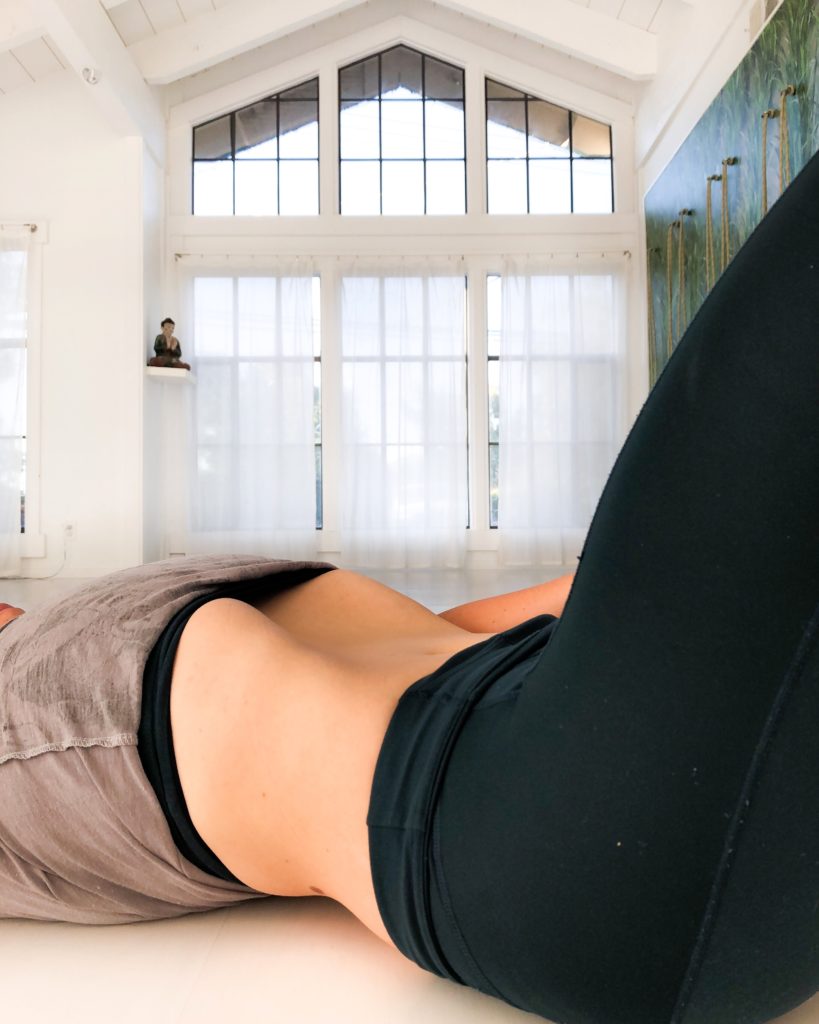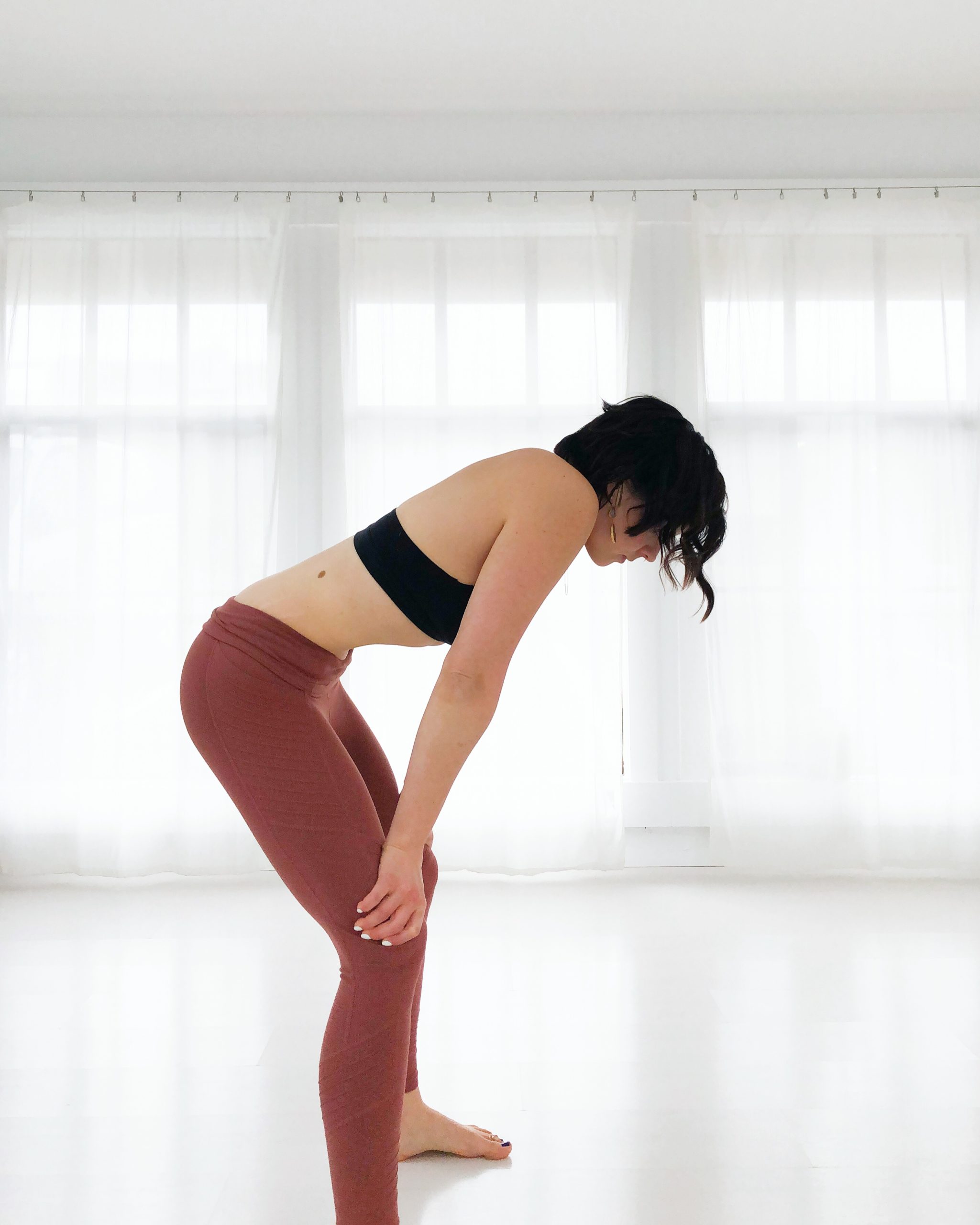Uddi-what? If you’ve ever been to my classes, workshops, or retreats, you’ve probably tried it with me. It’s one of my favorite “advanced” practices. I love to teach it, and I love to do it. It’s also one of the things I get the most questions and comments about during and after classes.
If you want to be walked through while you practice or want to listen to all this information, check out our Membership Episode on Uddiyana Bandha here.
What is it?
Uddiyana means “to rise up” or “fly.”
Bandha means “lock”, “to bind” or “to hold captive.”
In English it’s sometimes called abdominal lock, upward lifting lock or abdominal vacuum, although that can be different.
A lock or a bandha in hatha yoga is a movement where a part of the body is sealed, constricted, or closed off somehow. There are three bandha or locks, and then there’s the 4th one when you use all of them at the same time. The pelvic floor lock, called Mula Bandha, is probably the most known and the most practiced, sometimes even over practiced. There’s the throat lock or the chin lock called Jalandhara Bandha, and then there is our Uddiyana Bandha, the upward flying lock or the abdominal lock. In my opinion, That’s the most powerful one.
Uddiyana Bandha was mentioned in the Hatha Yoga Pradipika, a classic yogic text from the 15 century. However, you’ll find different dates around, sometimes as old as the 6th century, so it’s really not a new practice.
Of all the Bandhas, Uddiyana is the best, for by its activation liberation comes spontaneously”
– Hatha Yoga Pradipika.
You’ll find it often in Ashtanga, Jivamukti, advanced Vinyasa classes, and Kundalini. A bit less often in Iyengar and Bikram, it really depends on the teacher, and I’ve seen it in yin, but in a very yin-like variation of it. It is very possible you have been in a class where the teacher explicitly taught it, and it’s possible you’ve been in a class, and the teacher asked to do it without breaking it down for you as well.
What does it looks?

At the end of an exhalation, you hold your breath on empty, and you suck the diaphragm up from the strength of the throat as you widen the ribcage and relax the core. Your abdominal wall comes in and up and the organs are pulled up to a higher than their normal position in the trunk by the vacuuming effect in the chest. Since you have no air in the lungs, there’s space for everything to come up a little higher. And then you hold that breath captive for a little bit.
Why do we practice it? Why do I teach it?
This is the question I get the most often on Uddiyana Bandha. Here are the top believed benefits.
- Enables you to exhale more completely and breathe more comfortably and efficiently.
- Helps you feel calmer and more at ease.
- Strengthens the abdominal muscles and diaphragm.
- Helps control movement in certain asanas.
- Massages the abdominal organs, the heart and lungs.
- Increases gastric fire; improves digestion, assimilation, and elimination.
- Stimulates blood circulation in the abdomen and increases blood flow to the brain.
- Stimulates and lifts the energy of the lower belly (apana vayu), to unite it with the energies localized in the navel (samana vayu) and heart (prana vayu).
- It moves the energy from the 3 lower chakras toward the heart and higher chakras.
- Stops the movement of prana (the vital life force, or energy). According to the Hatha Yoga Pradipika, when the energy stops moving, the mind stops moving as well. so it’s helpful to clear and quiet the mind.
- Improves the Vagus nerve function which means that the nervous system is more efficient.
Those are all excellent reasons to practice it…I personally practice it for the impact it has on my nervous system. It’s clear as day. It helps me deal with stress and chronic pain.
Contra-indications
Avoid this practice if you have/are
- high blood pressure
- heart disease,
- hernias,
- ulcers,
- glaucoma,
- pregnant and menstruating.
How to do it?
- Deep abdominal-thoracic inhale
- Exhale completely. I usually suggest exhaling through the mouth and using some core strength to do it fairly rapidly. I also suggest making a shhhh sound at the end to make sure you actually have no more air.
- Relax your core, widen the ribs without inhaling. Pull diaphragm up from strength in the throat.
- Mock an inhalation (try to inhale without inhaling) while blocking your mouth and nose with your hands. You should feel your chest lift, or I like the image of sipping a thick milkshake through a straw…
- Hold it as long as you feel comfortable.
- Relax your face, let your chest and abdominal organs drop and your belly release forward.
- Add the other bandha for a little bit more containment of the energy. Drop your chin toward or into the little concavity just above your sternum. This is Jalandhra Bandha, the chin lock. Add Mula Bandha, the root lock, lifting the perineum up.
- Depending on the position, the arms can also help you by pushing the thighs away or reaching really long overhead.
Troubles? Here are tips and tricks!
The best time for practice is early in the morning, with empty stomachs and bowels.
You are not exhaling enough at the beginning. The less you exhale, the less convincing the lift will be.
You are letting a little air in on your mock inhalation. You have to try to inhale without doing so. That is the whole point of locking your airway at the glottis or of holding your nose and mouth at the end of the exhalation.
You are not relaxing your abdomen during the mock inhalation. This is the most common mistake. Many students hold their abdominal muscles rigidly or even mistakenly try to keep pushing in with them. If you keep them tight, the abdominal organs and abdominal wall cannot be sucked in and up.
Poses to try Uddiyana Bandha in
- Forward folds
- Seated poses like Sukhasana, padmasana
- Bridge Pose
- Goddess, horse stance
- Standing upright
- Reclined on your back both with arms overhead
- Kneeling position
- Jumping back to chaturanga
- Jumping forward from Downward Facing Dog
- Pressing into handstand
- Transitioning in and out of arms balances
What’s next?
Listen to our Member Episode and try it for yourself!

+ show Comments
- Hide Comments
add a comment